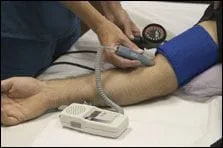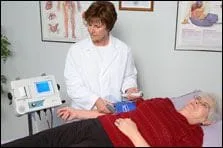P.A.D. is a common condition that affects 8-12 million people in the US every year. There is a 45.4% prevelance among individuals ages 65 and older. It is a type of Peripheral Vascular Disease (PVD) that is characterized by the narrowing of the arteries most commonly in the legs caused by plaque build-up, often referred to as Atherosclerosis. The plaque build-up then diminishes the blood supply to the extremities, potentially causing harmful complications.
P.A.D. is a serious under-diagnosed, under-treated disease. It is often referred to as a silent killer, as most people show no symptoms of P.A.D. If you have P.A.D. your chances of a long life are reduced dramatically, and the risk of heart attack or stroke is increased 7-10 times. Over 120,000 amputations, in the US, annually are caused from P.A.D. The most evident symptom is leg pain when exercising, which subsides with rest - referred to as claudication. Unfortunately, most people attribute pain while walking or exercising to the aging process and don't receive proper diagnoses - leg pain is NOT normal.
Who is at risk for P.A.D.?
As we age, our risk of P.A.D. progressively increases. Other risk factors include:
- Diabetes
- Smoke Currently or in the Past
- High Blood Pressure
- High Cholesterol
- Obesity
- Family History of Heart Disease
- Previous Heart Disease
All of these risk factors are cumulative.
How does the Doctor test for P.A.D.?
The most common test for diagnosing P.A.D. is a simple non-invasive test called the Ankle Brachial Index (ABI). The ABI exam is the "Gold Standard" for diagnosing P.A.D., which uses Doppler equipment along with blood pressure cuffs and aneroid. The test measures the systolic pressure of the lower and upper extremities, similar to checking your blood pressure. If the ankle pressure is lower than the arm pressure you may have some stage of Peripheral Arterial Disease.

|

|

|
What are the Signs and Symptoms of P.A.D.?
If they are present, the typical signs and symptoms of the disease include:
- Claudication -- fatigue, heaviness, tiredness, cramping in the leg muscles (buttocks, thigh, or calf) that occurs during activity such as walking or climbing stairs. This pain or discomfort goes away once the activity is stopped and during rest. Many people do not report this problem to their health care providers because they think it is a natural part of aging or due to some other cause.
- Pain in the legs and/or feet that disturbs sleep.
- Sores or wounds on toes, feet, or legs that heal slowly, poorly, or not at all.
- Color changes in the skin of the feet, including paleness or blueness.
- A lower temperature in one leg compared to the other leg.
- Poor nail growth and decreased hair growth on toes and legs.
However, most people with P.A.D. do not experience symptoms. If you believe you are at risk for P.A.D., discuss this concern with us during your appointment.
Is there a cure for P.A.D.?
Although there is no cure for P.A.D., there are many ways to treat the disease. Depending on the severity of the disease it can be as straightforward as good healthcare practices including diet, exercise and elimination of smoking. Medications are available that reduce the plaque build-up, and in severe cases of P.A.D. there are many different forms of surgery that can clear the blockage.
Where do I get tested?
Our office can now test you for P.A.D. in the comfort of a treatment room. The test is non-invasive and can tell us if a specific artery is open or blocked. Call our office to schedule an evaluation and test if you have any of the above symptoms. Remember that diagnosing P.A.D. is the first step in getting the proper treatment.
